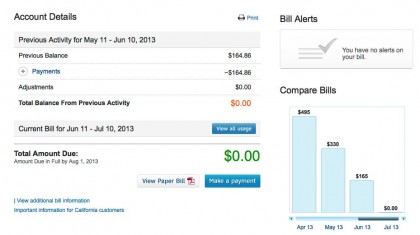AT&T Next: what you need to know
The give and take of AT&T's early upgrade plan
Your wireless bill stays the same, subsidy included
While you're paying relatively inexpensive monthly installments for your device, you're still responsible for your wireless bill. Current customers will find their wireless bill stays the same when they sign up for Next - only the device's monthly installments are added on top.
Under normal, non-Next circumstances, customers (at most carriers, not just AT&T) buy a phone at a subsidized price, or a price that's significantly lower than the face value of the phone. An unsubsidized, unlocked 64GB iPhone 5S, for example, would cost $849 to purchase outright.
Additionally, if you get a phone on a 24-month contract but don't want to keep it after six months, you can pay an early termination fee (a smartphone "that requires a data plan with a service commitment" has a $325 ETF minus $10 for each month paid of the agreement) and the phone is yours to do with what you please. With a tablet, one purchased with a service agreement on or after November 9, 2012 has a $150 ETF minus $4 for every month completed of the agreement.
But back to subsidies, a 64GB iPhone 5S purchased on contract at AT&T costs $399. AT&T makes up for the cost lost here by including a subsidy in a customer's monthly service bill, which most estimates place at around $20 (AT&T has been reticent to disclose this figure).

At the end of an agreement or after paying an ETF, the phone belongs to the owner. They get to keep the phone.
Because the service bill price doesn't change with Next, customers are still paying a subsidy on top of their wireless payment on top of their monthly installment. In order to get an upgrade after 12 months, they have to trade in their phone (or tablet, whatever the case may be). So unlike a device purchased at a subsidized price, customers don't get to keep their Next device.
How is it different from AT&T's standard upgrade programs?
With a standard plan, customers become eligible for an upgrade after 24 months. AT&T used to offer upgrades after 20 months, but in June extended the wait time for customers whose contracts expire during or after March 2014.
Get daily insight, inspiration and deals in your inbox
Sign up for breaking news, reviews, opinion, top tech deals, and more.
Upgradeable devices are offered at a subsidized price, and customers can purchase the device at that price along with a new two-year agreement.
Those looking to upgrade can also share an upgrade with someone else on their account. They must be upgrading within the same device category (no tablet for a phone, and vice versa). AT&T doesn't allow cross-product category upgrades with Next, either.
Should you become sick of your device and want to upgrade early, you can do so after six months on your wireless agreement. AT&T will give qualifying customers a partial discount off the full retail price of their phone, but they have to sign up for a new two-year agreement.
The main difference between AT&T's standards upgrades and Next is that customers don't have to wait two years for to upgrade or for some other circumstances to fall into place.
Who can use AT&T Next?
Next is available to both new and existing AT&T customers with qualifying credit.
The service is currently only available for personal lines.
What devices can I get with Next?
At the time of this writing, AT&T listed 26 smartphones as eligible for Next. With monthly installment prices, they are:
- Apple iPhone 5S - $27/month
- Apple iPhone 5C - $22/month
- Moto X - $22/month
- Apple iPhone 4S - $17/month
- Samsung Galaxy S3 Mini - $14/month
- Samsung Galaxy Note 3 - $35/month
- HTC One Mini - $21/month
- Samsung Galaxy Mega - $24/month
- LG G2 - $27/month
- Nokia Lumia 925 - $21/month
- Nokia Lumia 920 - $15/month
- BlackBerry Z10 - $15/month
- HTC Windows Phone 8X - $15/month
- BlackBerry Curve 9360 - $14.25/month
- LG Optimus G - $17/month
- Samsung Galaxy S3 - $22/month
- LG Optimus G Pro - $20/month
- NEC Terrain - $18/month
- Galaxy Rugby Pro - $18/month
- Apple iPhone 5 - $22/month
- Nokia Lumia 1020 - $27/month
- Samsung Galaxy S4 - $27/month
- Samsung Galaxy S4 Active - $26/month
- HTC One - $27/month
- BlackBerry Q10 - $26/month
- Samsung Galaxy Note 2 - $28/month
AT&T's nine eligible tablets, with monthly pricing, are:
- Apple iPad Air with Wi-Fi plus Cellular - $31.50
- Samsung Galaxy Tab 3 7.0 - $15/month
- Asus MeMO Pad FHD 10 LTE - $20/month
- Samsung Galaxy Note 8.0 - $25/month
- Apple iPad 2 with Wi-Fi plus 3G (16GB) - $26.50/month
- Apple iPad mini with Wi-Fi plus Cellular - $21.50/month
- Samsung Galaxy Tab 2 10.1 - $22.50/month
- Apple iPad with Retina display Wi-Fi plus Cellular - $29/month
- Asus ViviTab RT - $35/month
With devices that AT&T carries in different storage configurations, the monthly price generally goes up. The iPad mini Wi-Fi plus Cellular 16GB may cost $21.50/month, but the 32GB is $26.50/month and the 64GB costs $31.50/month. The iPhone 5S goes from $27/month for 16GB to $37/month for 64GB.
AT&T warns that for returned devices, a $35 restocking fee may be charged for smartphones or 10% of the tablet price.
The bottom line
Clearly there are some trade-offs with AT&T Next. For the privilege of an early upgrade, customers essentially double pay for a device they don't get to keep.
The out-of-store cost of a Next is cheaper, and the monthly payments may make financial sense for some, but the only way to keep the device is to pay off its full price.
When it comes to deciding whether to join up with Next, it boils down to personal preference. Is grabbing early access to a new device you may not keep incentive enough to swallow more in the long term? Or would you rather stick with a two-year agreement and wait out your upgrade or pay an ETF to get a newer phone or tablet?
Michelle was previously a news editor at TechRadar, leading consumer tech news and reviews. Michelle is now a Content Strategist at Facebook. A versatile, highly effective content writer and skilled editor with a keen eye for detail, Michelle is a collaborative problem solver and covered everything from smartwatches and microprocessors to VR and self-driving cars.
